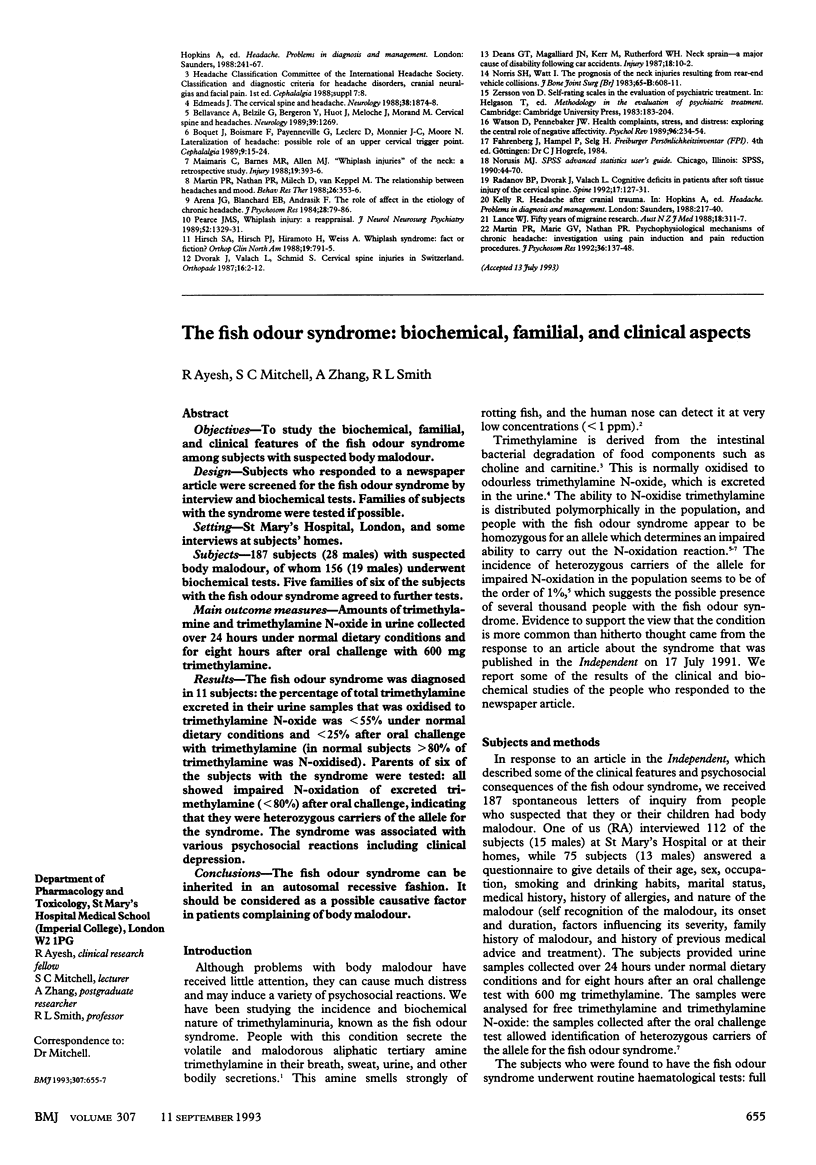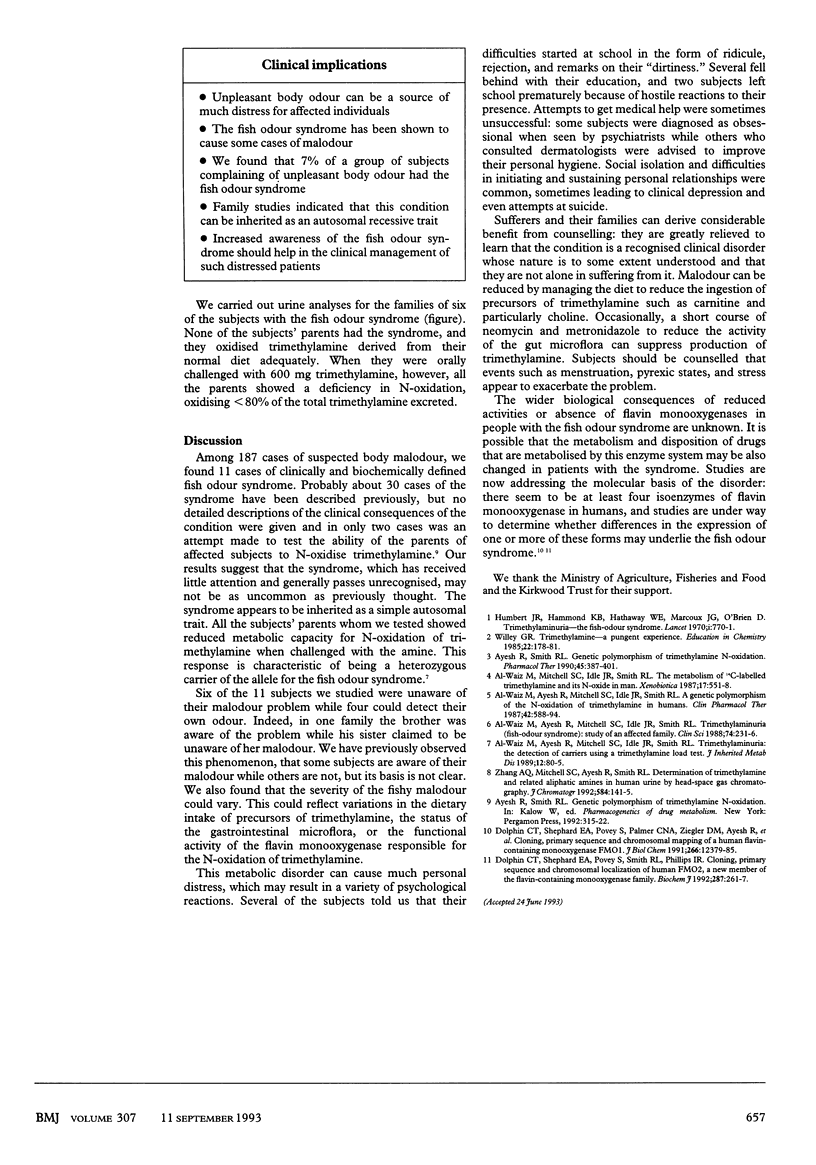Abstract
OBJECTIVES--To study the biochemical, familial, and clinical features of the fish odour syndrome among subjects with suspected body malodour. DESIGN--Subjects who responded to a newspaper article were screened for the fish odour syndrome by interview and biochemical tests. Families of subjects with the syndrome were tested if possible. SETTING--St Mary's Hospital, London, and some interviews at subjects' homes. SUBJECTS--187 subjects (28 males) with suspected body malodour, of whom 156 (19 males) underwent biochemical tests. Five families of six of the subjects with the fish odour syndrome agreed to further tests. MAIN OUTCOME MEASURES--Amounts of trimethylamine and trimethylamine N-oxide in urine collected over 24 hours under normal dietary conditions and for eight hours after oral challenge with 600 mg trimethylamine. RESULTS--The fish odour syndrome was diagnosed in 11 subjects: the percentage of total trimethylamine excreted in their urine samples that was oxidised to trimethylamine N-oxide was < 55% under normal dietary conditions and < 25% after oral challenge with trimethylamine (in normal subjects > 80% of trimethylamine was N-oxidised). Parents of six of the subjects with the syndrome were tested: all showed impaired N-oxidation of excreted trimethylamine (< 80%) after oral challenge, indicating that they were heterozygous carriers of the allele for the syndrome. The syndrome was associated with various psychosocial reactions including clinical depression. CONCLUSIONS--The fish odour syndrome can be inherited in an autosomal recessive fashion. It should be considered as a possible causative factor in patients complaining of body malodour.
Full text
PDF


Selected References
These references are in PubMed. This may not be the complete list of references from this article.
- Al-Waiz M., Ayesh R., Mitchell S. C., Idle J. R., Smith R. L. A genetic polymorphism of the N-oxidation of trimethylamine in humans. Clin Pharmacol Ther. 1987 Nov;42(5):588–594. doi: 10.1038/clpt.1987.201. [DOI] [PubMed] [Google Scholar]
- Al-Waiz M., Ayesh R., Mitchell S. C., Idle J. R., Smith R. L. Trimethylaminuria ('fish-odour syndrome'): a study of an affected family. Clin Sci (Lond) 1988 Mar;74(3):231–236. doi: 10.1042/cs0740231. [DOI] [PubMed] [Google Scholar]
- Al-Waiz M., Mitchell S. C., Idle J. R., Smith R. L. The metabolism of 14C-labelled trimethylamine and its N-oxide in man. Xenobiotica. 1987 May;17(5):551–558. doi: 10.3109/00498258709043962. [DOI] [PubMed] [Google Scholar]
- Ayesh R., Smith R. L. Genetic polymorphism of trimethylamine N-oxidation. Pharmacol Ther. 1990;45(3):387–401. doi: 10.1016/0163-7258(90)90074-c. [DOI] [PubMed] [Google Scholar]
- Dolphin C. T., Shephard E. A., Povey S., Smith R. L., Phillips I. R. Cloning, primary sequence and chromosomal localization of human FMO2, a new member of the flavin-containing mono-oxygenase family. Biochem J. 1992 Oct 1;287(Pt 1):261–267. doi: 10.1042/bj2870261. [DOI] [PMC free article] [PubMed] [Google Scholar]
- Dolphin C., Shephard E. A., Povey S., Palmer C. N., Ziegler D. M., Ayesh R., Smith R. L., Phillips I. R. Cloning, primary sequence, and chromosomal mapping of a human flavin-containing monooxygenase (FMO1). J Biol Chem. 1991 Jul 5;266(19):12379–12385. [PubMed] [Google Scholar]
- Humbert J. A., Hammond K. B., Hathaway W. E. Trimethylaminuria: the fish-odour syndrome. Lancet. 1970 Oct 10;2(7676):770–771. doi: 10.1016/s0140-6736(70)90241-2. [DOI] [PubMed] [Google Scholar]
- Zhang A. Q., Mitchell S. C., Ayesh R., Smith R. L. Determination of trimethylamine and related aliphatic amines in human urine by head-space gas chromatography. J Chromatogr. 1992 Dec 23;584(2):141–145. doi: 10.1016/0378-4347(92)80569-c. [DOI] [PubMed] [Google Scholar]
- al-Waiz M., Ayesh R., Mitchell S. C., Idle J. R., Smith R. L. Trimethylaminuria: the detection of carriers using a trimethylamine load test. J Inherit Metab Dis. 1989;12(1):80–85. doi: 10.1007/BF01805534. [DOI] [PubMed] [Google Scholar]


